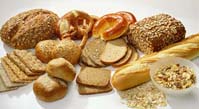FDA issues guidance on whole-grain content
For the first time, the federal government yesterday issued an official definition of whole-grain foods. The long-awaited nutritional guidance is designed to help consumers sort through a confusing -- and sometimes misleading -- array of foods that purport to contain whole grains but often do not.

Federal Dietary Guidelines issued last year recommend that Americans eat at least three one-ounce servings of whole grains daily, as they are proven to help cut heart disease and cancer risk. But until now, there has been no official definition of whole grains and no easy way for consumers to know that cracked wheat, stone-ground wheat, ordinary wheat flour and many other seemingly whole-grain ingredients are not the real thing.
"That's the problem," said Bonnie Liebman, nutrition director at the Center for Science in the Public Interest, a consumer advocacy group. "Many of these foods have a mixture of whole and refined grains. You may be eating three times as much of the refined grains as the whole grains", reports Washington Post.
"One of the most important decisions people can make about their health is the choice of foods they eat," said Dr. Scott Gottlieb, FDA's deputy commissioner for medical and scientific affairs, in a statement Wednesday. "A top priority at FDA is finding additional ways to clearly communicate the health benefits found in food."
The FDA considers whole grain to include cereal grains that consist of the intact, ground, cracked or flaked fruit of the grains. The grain's principal components - the starchy endosperm, germ and bran - are also in the same relative proportions as they exist in the intact grain. Such grains may include barley, buckwheat, bulgur and corn.
The FDA said the grain refining process can lead to the removal of some of the bran and germ, resulting in a loss of dietary fibre, vitamins and minerals.
The food industry has also been looking for guidance from the FDA about whole-grain labels, said a spokesperson for the Grocery Manufacturers Association.
Canada's food guide recommends eating five to twelve servings of grain products per day. A serving can include one slice of bread, half a bagel or 30 grams of cold cereal, informs CBC News.
O.Ch.
Subscribe to Pravda.Ru Telegram channel, Facebook, RSS!


